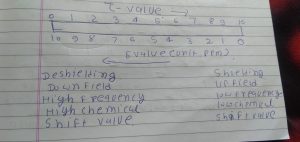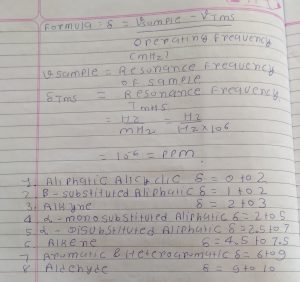SOLVENT USED IN NMR & CHEMICAL SHIFT,MCQ
SOLVENT USED IN NMR
Solvent that are used in NMR should not contain Hydrogen atom.
It is magnetically isotropic in nature means all directions they are equally magnetic field.
Solvent are also following characteristics chemically inactive, volatile in nature, solvent able to dissolve the sample approximately 10%.
Example of solvent used in NMR :-
- Carbon tetrachloride (CCL4),
- Deuterated water(D20),
- Deuterated methanol(CD3OD) etc.
Chemical shift :-
Chemical shift is the difference between the absorption position of a sample proton and the absorption position of the reference compound.
OR
Chemical shift is difference in PPM the resonance frequency of the observed proton and tetramethylsilane (TMS) hydrogen.
Position of proton help to the understanding the nature of the proton in compound.
e¯ will produce secondary magnetic field.
- If sec. Magnetic field is opposite of external magnetic field it is produced shielding effect and goes upfield.
- If sec. Magnetic field is rein forced of external magnetic field it is produced deshielding effect and goes Downfield.


Factor affecting chemical shift
1. Inductive effect :- when proton is attached with any electro negative group. Then proton will be deshielding and chemical shift will be increased.
2. Steric effect :– due to presence of bulk group will repell the e¯ could of proton due to electrostatic repusion.
Increase deshielding so increase chemical shift value.
3. Hydrogen bonding :- Hydrogen atom goes for hydrogen bonding with two electronegative atom
They will take the e¯ cloud from H and it will be deshielded.
Due to deshielding chemical shift value will be higher.
4. Hybridization :-

MCQ
1. How many percentage sample dissolve in NMR solvent ?
A. 10% or more
B. 5% or more
C. 10% or less
D.5 %or less
Ans. A
2. Which solvent is used in NMR ?
A. Water
B. Chloroform
C. Benzene
D. Dinitro benzene
Ans.D
3. Chemical shift unit is ?
A. Mm
B. Cm
C.PPM
D. None
Ans c
4. Chemical shift value of alipatic alicyclic is
A. O to 2
B. 1 to 2
C. 3 to 4
D. 4 to 5
Ans. A
5. Chemical shift value of Alkyne
A. 3 to 4
B. 2 to 3
C. 1 to 2
D. 5 to 8
Ans. B
6.Chemical shift value of aldehyde
A. 9 to 10
B . 8 to 9
C. 1 to 2
D. 5 to 8
Ans. A
7. SP hybridization possessed
A. Mild chemical shift
B. High chemical shift
C. Low chemical shift
D. All of the above
Ans. B
8. Due to increase hydrogen bonding
A. Deshielding
B. Shielding
C. Increase chemical shift
D. A and C
Ans. D
9. In steric effects
A. chemical shift value increase
B. chemical shift value decrease
C. A and B value
D. None of this
Ans. A
10.Chemical shift value of hetero aromatic
A. 6 to 9
B. 2 to 3
C. 1 to 5
D. 2 to 5
Ans A